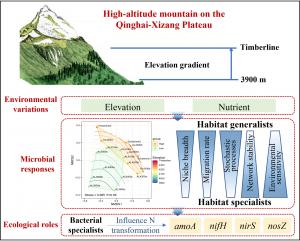Tiny titans at high elevations: how soil microbes sustain forest resilience
GA, UNITED STATES, May 12, 2025 /EINPresswire.com/ -- High-altitude forest soils host microscopic communities with outsized influence on ecosystem stability. A recent study unveiled how microbial sub-communities—generalists, intermediates, and specialists—respond to environmental changes along the towering Shergyla Mountain in the Qinghai-Xizang Plateau. While generalists flourish across a wide range of conditions, it is the lesser-known specialists, sensitive to subtle shifts in the environment, that serve as central nodes in microbial interaction networks and contribute disproportionately to nitrogen cycling. The findings reveal the hidden architects of biodiversity in one of the planet’s most extreme environments—and highlight the critical importance of preserving them.
Rising thousands of meters above sea level, the Qinghai-Xizang Plateau—often dubbed the “Third Pole”—offers a natural laboratory for exploring how life adapts to environmental extremes. Elevation-induced changes in temperature, moisture, and nutrients shape not just the physical landscape but also the microbial ecosystems beneath the soil. Microorganisms, essential for nutrient cycling and forest health, vary in their adaptability: generalists thrive in a broad range of environments, while specialists inhabit narrow ecological niches. Despite growing recognition of microbial contributions to ecosystem function, the dynamics of these specialized groups remain poorly understood. Because of these knowledge gaps, deeper investigation into microbial assembly and function is urgently needed.
To address this, a research team from Hohai University, Sichuan University of Science and Engineering and Institute of Science and Technology Information Research of Xizang Autonomous Region, China conducted a comprehensive study, published on December 23, 2024, in Frontiers of Environmental Science & Engineering. Focusing on forest soils spanning elevations from 3900 meters to the timberline on Shergyla Mountain, the team employed high-throughput sequencing, ecological network analysis, and nitrogen gene profiling to examine microbial diversity and ecological roles. Their findings provide rare insight into how microbes structure themselves in response to one of Earth’s most challenging environments.
The researchers identified over 14,000 microbial operational taxonomic units (OTUs) and categorized them into generalists, intermediates, and specialists. Specialists—though less widespread—displayed remarkable sensitivity to environmental factors such as total phosphorus, moisture content, and ammonium. Their presence and behavior were governed by deterministic ecological processes, including environmental filtering, in contrast to generalists who were more randomly distributed due to dispersal and drift. Intriguingly, specialists formed highly connected nodes in microbial co-occurrence networks, acting as keystone taxa vital to community stability. Nitrogen cycling genes—including nifH, amoA, nirS, and nosZ—were strongly associated with bacterial specialists and followed a distinct U-shaped pattern across elevation, underscoring their role in nutrient transformation. The study paints a vivid picture of life at altitude: generalists offer breadth, but it is the specialists—fragile yet foundational—that hold the microbial community together.
“Microbial specialists are often overlooked due to their limited range, but they are the unsung heroes of ecosystem resilience,” said Dr. Yi Li, co-corresponding author of the study. “Their heightened environmental sensitivity and central positions within microbial networks make them not just indicators of environmental change, but active agents in maintaining soil and forest health. As we face escalating climate challenges, understanding their behavior is essential for high-altitude ecosystem conservation.”
The research lays crucial groundwork for forecasting how climate-driven shifts in elevation-related variables could transform soil microbial landscapes. By recognizing the ecological importance of specialists, the study provides a new framework for biodiversity monitoring and adaptive forest management in alpine regions. It emphasizes the need to preserve environmental heterogeneity—a key driver of microbial diversity—which is essential for sustaining ecosystem functions like nutrient cycling amid global change.
References
DOI
10.1007/s11783-025-1950-6
Original Source URL
https://doi.org/10.1007/s11783-025-1950-6
Funding information
This work was supported by the Fundamental Research Funds for the Central Universities (China) (No. B240201049), the China Postdoctoral Science Foundation (No. 376371) and the Six Talent Peaks Project in Jiangsu Province (China) (No. 2016-JNHB-007).
Lucy Wang
BioDesign Research
email us here
Legal Disclaimer:
EIN Presswire provides this news content "as is" without warranty of any kind. We do not accept any responsibility or liability for the accuracy, content, images, videos, licenses, completeness, legality, or reliability of the information contained in this article. If you have any complaints or copyright issues related to this article, kindly contact the author above.
Synthetic Biology Market to Hit USD 84.7 Billion by 2035, Fueled by Advances in Gene Editing and Bio-Manufacturing
Zealmax Ortho at Pharmatech & Health, East Africa 2025, August 21-23, 2025
Metro East’s ISA Certified Arborists Offer 24/7 Emergency Tree Services to Protect Homes and Businesses
Więcej ważnych informacji
 Jedynka Newserii
Jedynka Newserii

 Jedynka Newserii
Jedynka Newserii

Farmacja

Nowy pakiet farmaceutyczny ma wyrównać szanse pacjentów w całej Unii. W Polsce na niektóre leki czeka się ponad dwa lata dłużej niż w Niemczech
Jeszcze pod przewodnictwem Polski Rada UE uzgodniła stanowisko w sprawie pakietu farmaceutycznego – największej reformy prawa lekowego od 20 lat. Ma on skrócić różnice w dostępie do terapii między krajami członkowskimi, które dziś sięgają nawet dwóch–trzech lat. W Unii Europejskiej wciąż brakuje terapii na ponad 6 tys. chorób rzadkich, a niedobory obejmują również leki ratujące życie. Nowe przepisy mają zapewnić szybszy dostęp do leków, wzmocnić konkurencyjność branży oraz zabezpieczyć dostawy.
Handel
Wzrost wydobycia ropy naftowej nie wpłynie na spadek cen surowca. Kierowcy jesienią zapłacą więcej za olej napędowy

Sierpień jest trzecim z rzędu miesiącem, gdy osiem krajów OPEC+ zwiększa podaż ropy naftowej na globalnym rynku; we wrześniu nastąpi kolejna zwyżka. Kraje OPEC, zwłaszcza Arabia Saudyjska, chcą w ten sposób odzyskać udziały w rynku utracone na skutek zmniejszenia wydobycia od 2022 roku, głównie na rzecz amerykańskich producentów. Nie należy się jednak spodziewać spadku cen ropy, gdyż popyt powinien być wysoki, a pod znakiem zapytania stoi dostępność ropy z Rosji. Nie zmienia to faktu, że jesienią ceny paliw na stacjach zazwyczaj rosną, a w największym stopniu podwyżki dotyczyć będą diesla.
Nauka
Szacowanie rzeczywistej liczby użytkowników miast dużym wyzwaniem. Statystycy wykorzystują dane z nowoczesnych źródeł

Różnica między liczbą rezydentów a rzeczywistą liczbą osób codziennie przebywających w Warszawie może sięgać nawet niemal pół miliona. Rozbieżności są dostrzegalne przede wszystkim w dużych miastach i ich obszarach funkcjonalnych. Precyzyjne dane populacyjne są tymczasem niezbędne w kształtowaniu usług społecznych i zdrowotnych, edukacyjnych, opiekuńczych, a także w planowaniu inwestycji infrastrukturalnych. W statystyce coraz częściej dane z oficjalnych źródeł, takich jak Zakład Ubezpieczeń Społecznych, są uzupełniane o te pochodzące od operatorów sieci komórkowych czy kart płatniczych.
Partner serwisu
Szkolenia

Akademia Newserii
Akademia Newserii to projekt, w ramach którego najlepsi polscy dziennikarze biznesowi, giełdowi oraz lifestylowi, a także szkoleniowcy z wieloletnim doświadczeniem dzielą się swoją wiedzą nt. pracy z mediami.









.gif)

 |
| |
| |
|